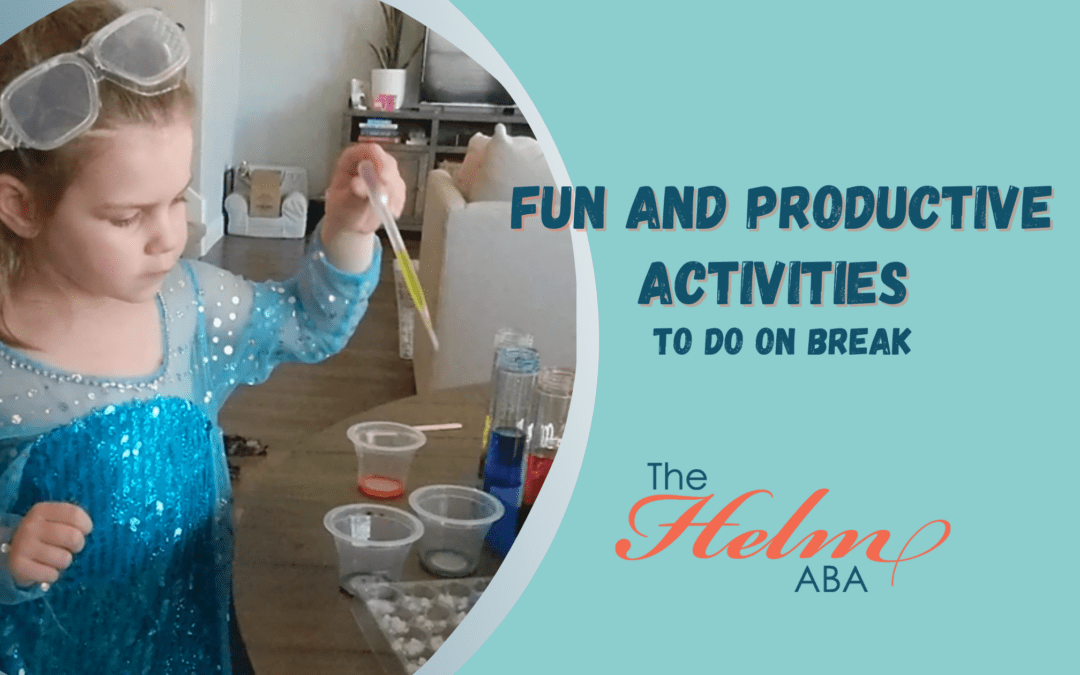When school (or The Helm) is out, kids have lots of free time—and parents might find themselves wondering how to fill the days with meaningful, engaging activities. For children with autism, keeping a structured routine is often key to avoiding meltdowns and maintaining balance. Here are some fun, sensory-friendly, and developmentally appropriate ideas to keep your kids happy and engaged during their break!
1. Create a Visual Schedule for the Week
Start by laying out a clear visual schedule. This helps children anticipate what’s coming next and reduces anxiety caused by unstructured time. Use pictures or icons for each activity—like outdoor play, meals, quiet time, or outings—to make it easy for them to follow along.
2. Sensory Play at Home
Engage in sensory activities that help your child relax and explore their creativity:
- Make sensory bins with rice, beans, or kinetic sand.
- Try DIY slime or playdough projects.
- Set up a water table with cups, sponges, and scoops.
These activities are fun and great for calming overstimulated kids.
3. Explore the Outdoors
Even a short walk or time at a park can work wonders for kids who have been cooped up. Nature trails, community playgrounds, or even your backyard can be a perfect spot for exploration. Bonus: You can incorporate scavenger hunts or outdoor yoga for added fun and movement!

4. Visit Local Attractions
Check out sensory-friendly events or quiet hours at local attractions like:
- Libraries offering storytime sessions.
- Zoos or aquariums with fewer crowds on weekdays.
- Museums with hands-on exhibits for kids.
Make sure to plan outings during off-peak times to avoid overwhelming your child.
5. Build Skills Through Fun Activities
You can sneak in some learning by playing games that build social, motor, and communication skills. For example:
- Board games or card games to teach turn-taking and patience.
- Simple cooking or baking projects that involve following instructions.
- Arts and crafts that encourage self-expression and fine motor skills.
6. Plan Playdates or Social Opportunities
Invite a familiar friend or family member for a short, low-pressure playdate. Keep it structured with activities like puzzles, building blocks, or cooperative games. Social interaction in small, predictable doses can help strengthen social skills.
7. Take Time to Relax
Breaks aren’t just for constant activity—downtime is just as important. Dedicate some time to quiet, low-energy activities like:
- Watching a favorite movie together.
- Listening to calming music or audiobooks.
- Reading a story or flipping through picture books.
8. Host a Mini “Camp” at Home
Set a theme for each day, such as:
- Science Day: Simple experiments like baking soda and vinegar volcanoes.
- Art Day: Paint, color, or craft to let their imaginations run wild.
- Music Day: Play instruments, sing, or dance together.
This can make each day feel exciting and purposeful.
9. Practice Life Skills
Take advantage of this time to practice skills your child may need to work on, like:
- Dressing independently.
- Setting the table.
- Cleaning up toys or helping with simple chores.
Turn it into a fun challenge with stickers or small rewards to keep them motivated.
10. Schedule “Parent Self-Care” Time
Don’t forget about yourself! While your child is engaged in an activity or taking a break, carve out some time to recharge. Even 15 minutes for a cup of tea or a quick stretch can make a big difference.
School or therapy breaks don’t have to be stressful. With a little planning, you can create a mix of fun, relaxation, and learning that works for both you and your child. Remember, the key is balance—structure the days but allow room for flexibility.
Want more tips for breaks or autism-friendly activities? Reach out to us at The Helm ABA. We’re here to help!

